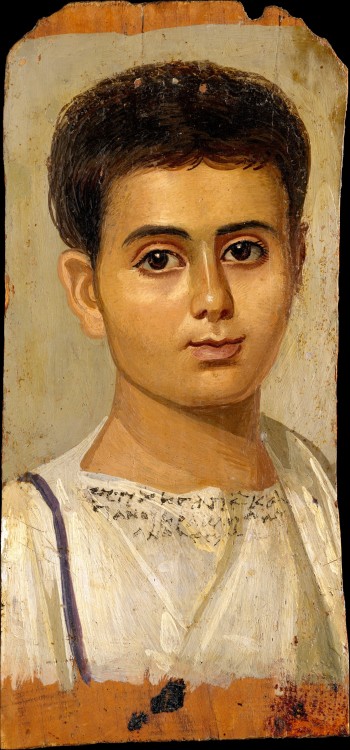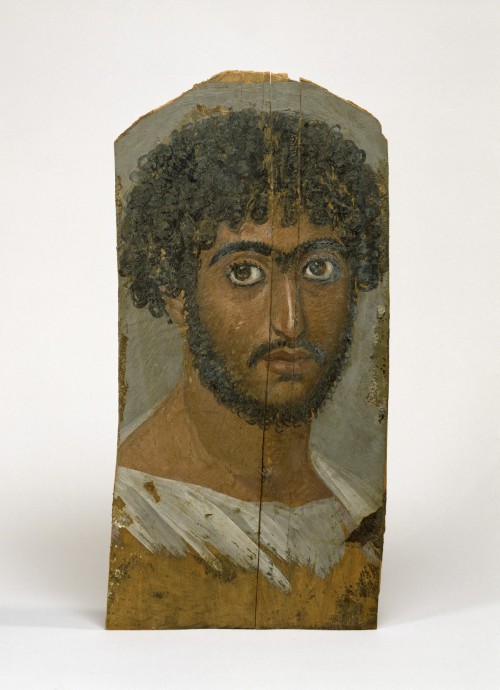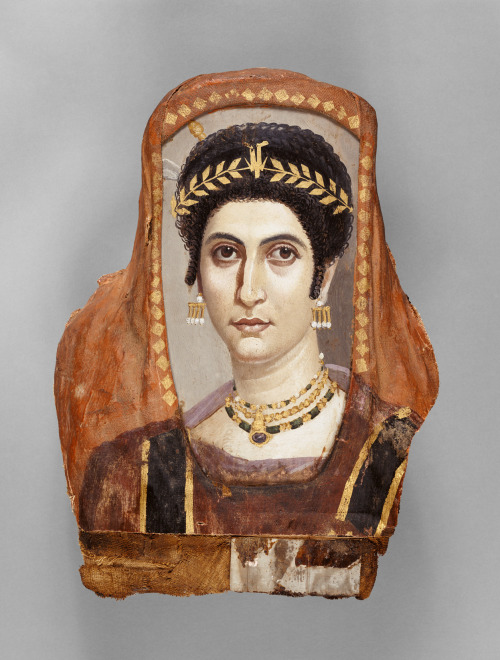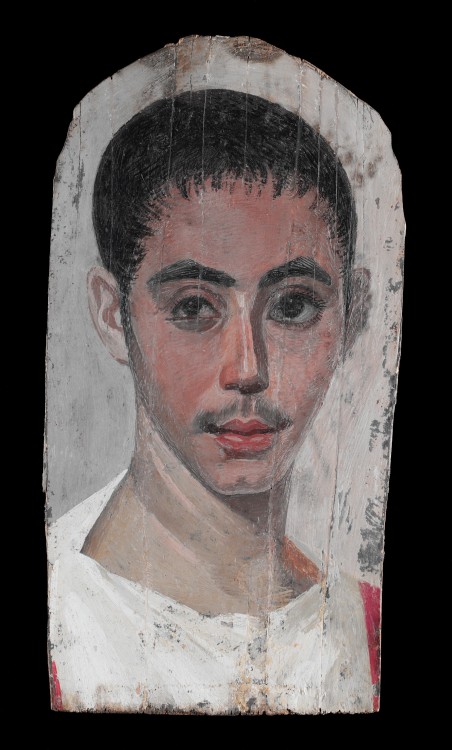ancientart: The closest we will get to photographs of Egyptians who lived during 30 B
ancientart: The closest we will get to photographs of Egyptians who lived during 30 BC-AD 324. Shown here a examples of the extraordinary mummy mask portraits produced in Egypt during the Roman period. These portraits were essentially the mixing of two traditions: the Roman interest in realistic portraiture, and mummification, which had been practiced in Egypt for millennia. These were most often painted in encaustic (a mixture of pigment and hot wax), on a wooden board, at an approximately lifelike scale. These wooden panels were then placed on the outside of the cartonnage coffin, either cautiously wrapped into the mummy bandages, or placed over the head of the deceased individual. The topic of the accuracy of the portraits has been heavily researched, and it is now clear that these portraits displayed the person as they appeared in life -with sometimes a bit of artistic licence. It has been possible for researchers to recognize members of a family through analyzing their physical similarities depicted, and to date some mummies on the basis of clothing, hairstyles and jewellery worn in the portrait. Now for a few points about the specific portraits shown as examples above (for more detailed accounts, check out the museum listings given below). All of these examples were, of course, found in Egypt. The ‘portrait of a thin-faced man’ shown first has remarkably free brushwork, and the man depicted displays a direct, intent gaze. The braids worn by the women in the 2nd example date the portrait to around the period of Roman emperor Trajan. The next portrait of a woman is attributed to the Malibu Painter. Dated to the Flavian dynasty by her hairstyle, she has incredibly large, expressive eyes, and her rich jewellery is indicative of her elite status. Perhaps the most remarkable of the portraits given in this post, the 4th example is of a young boy named Eutyches, who is dressed in a white Roman tunic, and looks calmly at the viewer. High rates of infant and child mortality, as attested to by this portrait, was an unfortunate reality of the ancient world in general. A bearded man is shown next, which dates to the Roman Imperial period. The portrait of a woman shown in the 6th image is attributed to the Isidora Master, and displays a mature women named Isidora, fully accessorized. A youth is displayed in the 7th portrait. Interestingly, a treated abnormality is evident in his right eye. Dating to the Roman Imperial period, the man displayed in the final example shown gazes confidently out at the viewer. While I always strongly encourage people to view all forms of ancient art in person, the mummy portraits of Roman Egypt are of the most remarkable to see face-to-face. If you are to see no other form of ancient art, if at all possible, go see examples of these, for they bring ancient history alive. As artist Euphrosyne Doxiadis stated: “The Fayum portraits have an almost disturbing lifelike quality and intensity. The illusion, when standing in front of them, is that of coming face to face with someone one has to answer to—someone real.” Portrait of a thin-faced man, AD 140–170, courtesy of the Metropolitan Museum of Art, New York: 09.181.3. Female Portrait Mask, 2nd century, courtesy of the Walters Art Museum, Baltimore: 32.5. Mummy Portrait of a Woman, AD 75-100, courtesy of the J. Paul Getty Museum, Villa Collection, Malibu, California: 73.AP.91. Portrait of the Boy Eutyches, AD 100–150, courtesy of the Metropolitan Museum of Art, New York: 18.9.2. Mummy Portrait of a Bearded Man, ca. AD 170-180, courtesy of the Walters Art Museum, Baltimore: 32.6. Mummy Portrait of a Woman, AD 100-110, courtesy of the J. Paul Getty Museum, Villa Collection, Malibu, California: 81.AP.42. Portrait of a Youth with a Surgical Cut in one Eye, AD 190–210 courtesy of the Metropolitan Museum of Art, New York: 09.181.4. Mummy Portrait of a Man, late 1st century, courtesy of the Walters Art Museum, Baltimore: 32.3. -- source link
Tumblr Blog : ancientart.tumblr.com
#history#portrait#amazing







